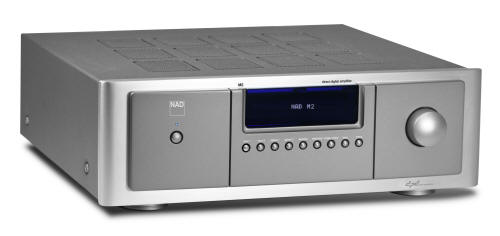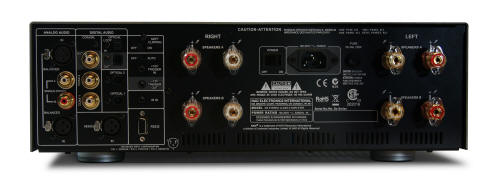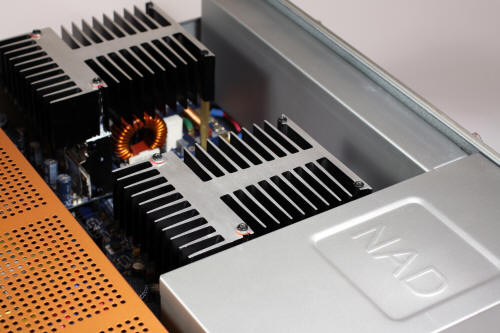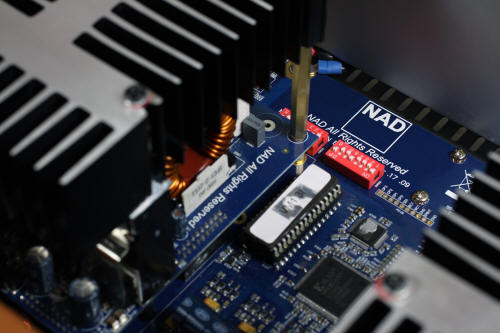|
|
You are reading the older HTML site
Positive Feedback ISSUE 66
nad M2 Direct Digital Amplifier - Truly Remarkable as reviewed by Jim Merod
Part the First
I have been a fan of NAD audio gear since the company began its push into the medium- to high-end audio market twenty-plus years ago. The consistency of reasonable price points that NAD set for its line of far "better than average" audio instruments attracted many musically inspired customers. I was one of those. In those optimistic days of "signal delivery transition" from vinyl over to the absolute emerging triumph of digital music reproduction, one's irritation with 16/44.1 sound was balanced against the portability of compact discs. Eagerly, an astute audiophile sucked up each shred of industry propaganda celebrating sonic breakthroughs to come. Promises of improved outcomes were mixed with admonitions that patience would ultimately be rewarded. We know, in retrospect, that droves of music lovers junked their LPs, sold or gave away their turntables, and swallowed the myth of digital audio nirvana out in the darkness of a lost horizon. After long weeks of audition, suspicious of the entire scene of a new audio format alongside the increasing onslaught of transistor-based reproduction gear, I held onto my Audio Research SP-8 tube preamp as I searched for a big ass amplifier. That was a difficult decision. I auditioned Krell, Levinson, and Spectral amps. None of them popped my cork. But even as that quest continued, I decided to buy a pair of the now legendary Dahlquist DQ-10 time-aligned "phase array" speakers that truly entranced me with what seemed like a virtually "you are there" sonic presence. My budget was stretched by the purchase and the radically disappointing Nakamichi amplifier I had ready in hopes of making such highly lyrical speakers soar to maximum lift off... which ultimately fell miles short of what I'd heard in the "Audio Perversity" showroom where my hopes had been roused by the immense charm of the Dahlquists. I had an insuperable dilemma. Call that extended moment of entangled longing and disappointment "part the first" of my ongoing interest in the NAD gang's creative swagger. The agony of driving a highly resistant speaker load with a finger-nails-on-the-blackboard amplifier performance motivated me to return to my pals at Perversity. Their inclination to match the DQ-10s with a NAD integrated amp had already created a magical form of musical joy. That was not merely a whim or subjective itch. I genuinely needed a superior playback system in order to have an adequate audio representation of my own live recordings. My recording gear was in the process of steady improvement and so my reproduction rig needed to catch up. I popped for a used NAD 3020. For many years that pairing operated faithfully as one of my two main listening systems. Even as another set of iconoclastic speakers (far more expensive than the DQ-10s) and a set of highly-modified, maximally-customized McCormack DNA amplifiers came into my audio world—sound as relaxed and natural, as beguiling and musically-accurate as any I've heard—the NAD/Dahlquist combination remained in place for the simple reason that, regardless of price, it made what Bill Murray calls "happy feet" and what I'll call smiling ears.
Part the Second
Fast forward to the present, a new century with black and white memories of glory days once fully Technicolor.
Eventually I made a permanent loan of my trusty NAD integrated amp to a dear friend, newly divorced and bereft of funds to splurge on audio, but in dire need of musical madness. Thus, the "loan" of my wonderful NAD 3020 without noting, at that moment of inspired generosity, the Diderot-inspired caution that no good deed is left unpunished. Or, at least, no non-negotiated "loan" of a piece of truly great audio gear will ever return home. I suppose it's useful to console oneself by recalling how often things that slip through one's paws disappear from memory entirely. That habit, of course, conforms to Nietzsche's health-inducing admonition that sanity depends on the art of forgetting (advice he apparently wasn't able to adequately internalize). Have you ever come across an old picture of your first youthful heart throb and found, to your amused if slightly shocked surprise, that this long out of mind object of once amorous glee was in truth a buck-toothed freckle-faced innocent with the visual pulchritude of cabbage salad? Reality always outflanks fantasy's allure. Sometimes, nonetheless, the return to the scene of a former delusion or dimly remembered victory encounters a sort of haunted welcome... as if time paused so your vision grew alert inside two frozen moments at once. Wordsworth perfected his early poetic awareness within the poignancy of such scenes and their fractured, fading animation.
For the sake of useful clarity, I'll restrict my pleased if, also, nostalgic recall of "the NAD magic" to something far closer to our current audio cosmos. Over time, I came to learn that the inner secret at the heart of my love affair with the still revered NAD 3020 integrated amp was a result of its uncanny ability to replicate the relaxed pace of any piece of well-recorded music. I did not, at the outset, realize that NAD gear carries an essentially unique sonic footprint characteristic of the brand's design topology. Back then, I assumed that my deeply happy experience with my DQ-10-NAD combo was merely (gloriously) synergistic. To some degree that was true, but as I paired the NAD box with a variety of speakers over time I came to hear that each speaker became more "musical." More sonically "sculpted" as if covertly attuned to the the song, the sound, the recording... the "everything" that goes into making highly-detailed recorded music and its replication.
I've regretted the absence of that wonderful (and wonderfully-bargain priced) 3020 joyful workhorse. For that reason I've looked for an opportunity to spend time with NAD gear in its twenty-first century iterations. So little time. So much gear to check out... but here, across the past few months as I've auditioned the NAD M "direct digital amplifier" in a series of configurations, it's become clear to me again that commonplace wisdom—received "truths" encountered on the street, what Plato turned his toxic idealism against, doxa—has the innate virtue of suggesting things to flee or, affirmatively, what intelligent curiosity ought to check out for itself. Take the well known "fact" that digital amplification is for the birds. There's an indisputable if inevitably debatable shard of drugstore philosophical brilliance. Over the last dozen years or more, I'll admit that every digital amp I've been invited to audition (usually with obsequious invocations of sonic profundity ready at hand to shiver my timbers) has failed to satisfy the least necessary criteria any audiophile witness holds dear. In a nutshell, my direct experience with the persistent state of digital amps and preamps has been desultory. Increasingly, I routinely backed away from requests to enjoy such slam-bam "digital sonic ecstasies." This is the occasion in which my refusal to consider reviewing the apparently oxymoronic reality of "digital amplification" has been overcome for the sake of NAD's anomalous direct digital triumph. What's Different Here? I suspect that the the NAD M2 may have suffered moments of audio mistreatment, perhaps caught in the commercial undertow of digital defamation in the chaos of the market. Received truths are hard to overcome, especially when negative perceptions are reinforced by entrenched media. All of us are deluged with audiophile gurus who are technically so hip that they "read" the sonic and musical values (the aesthetic viability and outright "worth") of a new piece of gear by scouring the component list and summing up the probable, or inevitable, lyrical outcome from that flinty-eyed inspection. Such intellectual suspicion is not out of line, but the reality of audio detective work is not relegated to theoretical logic. Watson always flubs the clues that Sherlock notes in passing and many apparently astute reviewers trust their intellect and deductive discernment at the expense of their hearing. Hearing loss is a serious issue across the years of mega-rock concert high-decibel bombardment. I have numerous friends whose loyal attendance at dozens of indoor and outdoor events left them damaged by the volume and frequency of that assault. I cannot know what the hearing acuity of any reviewer who reports I come across may be, but I'm more than skeptical of reviewers who cannot attest to the value of what they hear. Although I've found the emergence of digital amplification to have created by and large underwhelming sonic results, I'm more than pleased to find NAD's M2 integrated unit to fulfill expectations established by that company's decades-long (often ahead of the pack) high performance outcomes with a virtually unrivaled price/value ratio in favor of audio lovers with real world bank accounts. Let me disagree strongly regarding rumored negations in this joyous instance. Right out of the chute, the M2 grabbed hold of a vinyl feed from my Linn turntable (via an Audio Research phono preamp) and delivered the exoreic texture of Capitol Studio's awe-inspiring ambient reverb on a 180 gram pressing of Mancini's "Dreamsville" from the PETER GUNN, volume one, album. Like a child's articulate whisper in Santa's ear, it delivered amorous, enchanting delicacy with effortless dynamic allure. Mobile Fidelity's Ultradisc II high-res version of Duke Ellington's amazing sonic carnival, Jazz Party—fed from a Nuforce-modified OPPO transport to a Benchmark DAC-1 via Alan Yun's beyond compare AES digital cable directly into the M2 linked to Maggie 3.7 speakers—evaporated the room, the gear, and any sense that the experience was recorded and not, flat out, "real and alive" right here in Southern California 54 years after a small fleet of Columbia Records sound engineers crafted one of the most astonishing sonic captures ever. NAD's M2 delivered this landmark event as if it were imitating God paring his nails. On every one of this musically precise machine's inputs (and there are many) the unit's pedigree was in command. I'm not a fan of optical feeds, but both of these optical inputs own a signal fidelity that matches, nearly, the superior signal integrity of the single AES and two coax inputs. This may be an affiliated result of the remarkable clarity that NAD has achieved with its user-friendly optical loop mode that allows external digital processing to be carried out with zero sonic degeneration across the unit's loop function. Sitting Down, Taking It In, Hair Standing Straight Out The NAD M2 takes no prisoners and suffers no digital amp rival. The fact that the M2 is an integrated amp in an "all digital" configuration, giving equal sonic attention to its analog (both balanced and single-ended) inputs, is a testament to a design strategy clearly aimed at crafting a "statement" piece of high-end audio gear. However, that such a unit —delivering 200 watts (x2) into eight ohms; 250 watts (x2) into four ohms; cashing out majestically with 300 watts (x2) into two ohms—suggests that the NAD design team decided not merely to create a state of the art product, but to do so at a modest price point that no other amplifier that I'm aware of has equaled to date. Any recording engineer, or recording studio with high-end aspirations, could upgrade its ease of daily use and simplify complex ever-changing operations by snagging one of these bullet-proof musical behemoths. Enormous power is combined with enviable state-of-the-art sonic delicacy and accuracy. The M2 seems to be one of the few take no prisoners integrated boxes to achieve the trifecta of sheer sonic brilliance, musical engagement, and ease of such bold powerhouse finesse. The NAD M2 is a beautiful, heavy yet ballerina-like "Swiss army knife" for serious audiophiles who want the utmost maximum from a spectacularly versatile integrated amp... at a price that defies the quality and musical (emotional and technical) value tucked inside its Rolls Royce exterior. I want this unit for dozen reasons and thousands of instructive hours of delight. It is a recording engineer's best friend because of its effortless compatibility with ancillary gear. It is one of those ridiculously happy audio events that got invented before you knew you needed it. The M2 is a "must" whose doubters missed the last boat sailing onward, further out where audio sanity resides. Where's that kid whispering in Santa's ear? Jim Merod
M2 Direct Amplifier
NAD
|











